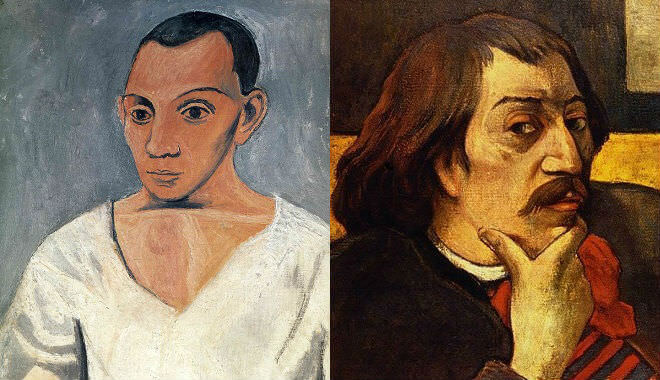Gauguin's Influence on Picasso

Paul Gauguin and Pablo Picasso had two very different journeys towards becoming artists. Gauguin, 33 years the elder, arrived at art after a career in finance. The younger Picasso was recognized for his artistic ability at a young age and began his career as an artist in Paris in 1900, at 19 years old.
It was early on, perhaps in 1901, that Picasso first saw the works of Gauguin. The two had a mutual friend, the artist Paco Durrio, who showed Picasso a piece by Gauguin, probably a ceramic work, although he also possessed various works on paper and paintings in his Montmartre studio. Picasso was interested in Gauguin's philosophy on art, as told by Durrio.
By this time, Gauguin has already lived the life of a world traveler, having his quarrels with Van Gogh in Arles, abandoning Paris for Tahiti, and living throughout the Polynesian islands, visiting Paris on occasion. He described his time in Tahiti in a book, Noa Noa, of which Picasso owned a copy and revered. Picasso was known to have annotated the pages with notes and drawings, taking inspiration from the experience that Gauguin described.
Gauguin and Picasso only shared a brief amount of time on earth working as artists, as Gauguin died in 1903. However short it may have been, the impact can be seen in a painting Picasso did upon hearing of Gauguin's death. In Standing Nude, 1903, Picasso shows a Tahitian woman walking, signed "PAUL Picasso"
However different their paths were, the similarities between the two men's art is remarkable. He was, quite literally, surrounded by the influence of Gauguin. While working on pottery in Durrio's studio Picasso was constantly in the presence of Gauguin works. In these early years, prior to 1907, Picasso was creating works in the same mediums as Gauguin; wood-cuts, ceramics, oil on canvas.
From his early days in Paris hearing about Gauguin and then reading his book Noa Noa, Picasso was fascinated by Gauguin's ideas on art. It was through Gauguin that the idea of Primitivism and the spiritual nature of people and art entered Picasso. Picasso was inspired by the way that Gauguin took his subjects out of the artificial environment of genre paintings and showed the emotion, the misery and loneliness, which people feel. Picasso showed this in his Blue Period, using poses and elements of costume taken from Gauguin paintings.
While it is true that seeing African masks would be the major spark to turn Picasso into an artist challenging the traditional conventions of art, it was that early influence of Gauguin that opened his mind to what art could be. Admiring Gauguin's travels, his ideas of showing the primitive nature of humans, and going beyond the norm in painting enabled Picasso to extend his artistic desires beyond anything previously imaginable. Without that early connection to Gauguin, it is impossible to know where Picasso would have gone as an artist.
















